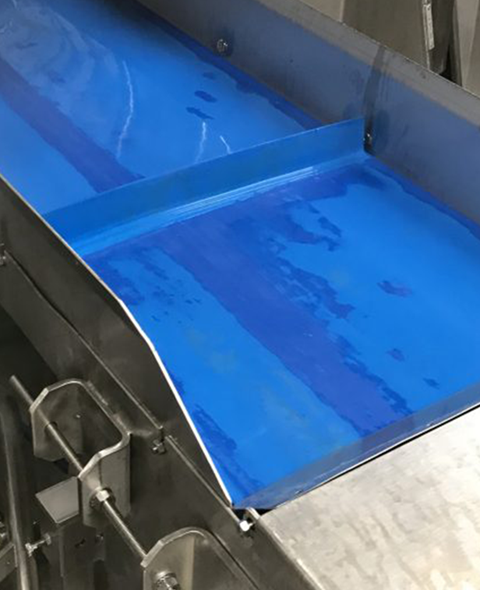
The Challenge
This was not the only shortcoming of the previous intestine conveyor belt. The conveyor drive also had repeated problems with defective bearings. This compromised the – in the truest sense of the word – smooth operation of the conveyor and consequently also the service life of the belt.
It was no longer possible to guarantee straight running in these cases. As a result, the motor in use needed to be regularly removed and the bearing replaced. There was also the danger of creating belt abrasion that could no longer be withstood laterally. Furthermore, short circuits occurred due to excessive water ingress. Ultimately, the motor failed completely at least twice a year, resulting in corresponding replacements and maintenance work. Continuous cleaning was also responsible for this unacceptable strain on the motor, which is considered to be a wear part. Taking a more moderate approach to the cleaning process was, however, not an option for Bell, as the highest hygienic standards must be met, particularly in the gutting process. Germs or other pathogens from gutted intestines must never be allowed to spread to other intestines that Bell prepares for use as natural intestines at the same plant

The Solution
SwissBeltService was commissioned to redesign the conveyor belt. They received the order due to their innovative proposal for the design of the drive. Firstly, the IP protection class of the drum motor currently in use was to be increased from IP67 to IP69k on account of the fact that the conveyor is cleaned with 65 degree Celsius hot water at a cool ambient temperature of 12 degrees Celsius for the entire operating period. From a design point of view, this choice is understandable, because under these conditions, protection against water penetration during high-pressure/steam jet cleaning and protection against hot water are required. Then there was the idea of knurling the drum of the motor so that the previously disruptive slippage caused by the unavoidable water between the belt and the drum motor can be prevented if the conveyor table and drum motor diameter are identical.
The knurling now ensures stability. The new belt has also been designed as a corrugated conveyor, so that the potential issue of abrasion in the event of belt imbalance is no longer a problem.

The Effect
Quick return on investment
On balance, the investment in the new design of the intestine conveyor belt has paid for itself within a very short time. So far, the new drum motor has only had to be purchased once initially. Previously, this was necessary three times in the same period, as the old motor broke down on average every six months. There is also no longer any need for interim motor maintenance in order to restore straight running and thereby operational capability by replacing the bearings. Furthermore, the knurling eliminates the need for manual intervention in the belt speed control to achieve parallel running, and there is certainly no prospect of an end to the smooth operation. A wear part has become a long-term reliable component with a high cost reduction factor.
The oil-free synchronous drum motors from Momentum are not only impressive because of their high IP protection class, but also because of their sturdy construction. For example, the motors have a solid 30 mm standardised axle that is far stronger than material-saving variants with 17 mm or 25 mm axles. The uniformly sturdy design of the drum motors testifies to a high level of customer orientation: The company, based in Hückelhoven, aims to offer the high-quality drum motors with the best possible durability at prices that pay for themselves within a short period of time. As a result, users benefit not only from reduced maintenance costs and a fast return on investment (ROI), but also from the sustainability of the design – a major factor that is becoming increasingly important in management decisions. According to the manufacturer, the mean time between failures (MTBF) for Momentum drum motors is twice as high as that of the competition under normal load situations, which is expected to result in 50% lower maintenance costs and almost double the ROI. At Bell, this factor is expected to be exceeded many times over, as the motors previously in use were not suitable for the application.


















